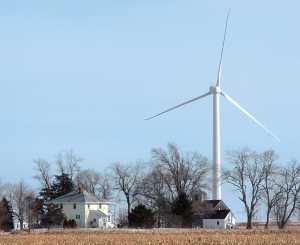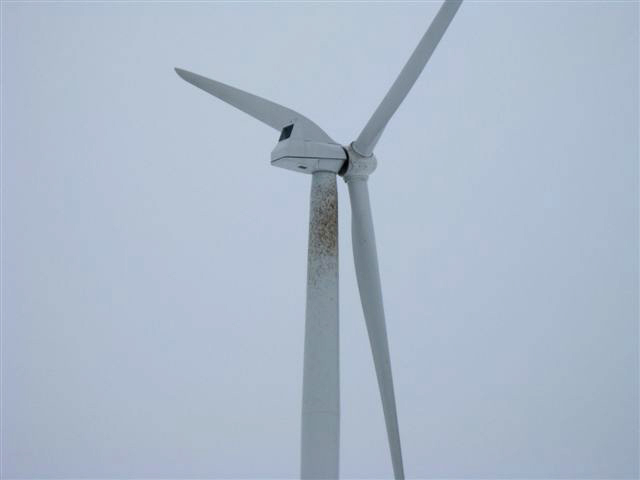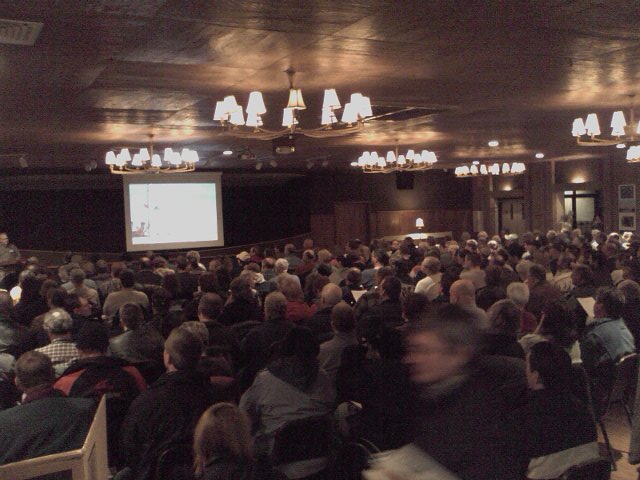
 Home in an Illinois wind farm
Home in an Illinois wind farm
Wind turbine sound needs research
Behind the Headlines is a service of NHS Choices. It provides an unbiased and evidence-based daily analysis of the science behind health stories that make the news. It aims to respond to stories the day they appear in the media.
Thursday January 28 2010
What were the NHS 'Behind the headlines' findings about the wind industry sponsored health study?
CONCLUSION: [The study is] a non-systematic review of literature. There are several points to be made about this research:
- There is no clear description of the methods the researchers used to search for available research, nor how they rated the quality of the research they found. Therefore, it is not possible to say that all relevant research was identified, or comment on the reliability of the research that was included.
- This review panel was commissioned by an industry group, and included a variety of academic perspectives, but not an epidemiologist. Someone with this specific skill set should be included when environmental health hazards are assessed.
- The link between psychological distress and physical symptoms has not been explored by this report. The acknowledgment that some people exposed to wind turbine noise suffer annoyance suggests that monitoring and maximum permitted levels need to be considered carefully in areas where turbines are planned.
Overall, this review will probably not resolve this controversy as there was a lack of high-level evidence on which to base any solid conclusions. What is now needed are studies that compare people exposed to turbine noise with well-matched control subjects who have not had that exposure. These studies should also carefully evaluate the psychological harms of noise exposure.
More research is needed on wind turbines and health
Source: NHS Choices Knowledge Service
“The noise caused by wind farms can make some people ill”, reported The Daily Telegraph. It said experts have dismissed the idea of a "wind turbine syndrome" as a special cause of headaches, nausea and panic attacks, but have acknowledged that the irritation caused by the noise can affect certain individuals.
The story is based on an industry commissioned review of the current research on the possible health effects of wind turbine noise. It found that the sound (including subaudible sound) is not unique, and does not pose a risk to human health. Although the sound may cause ‘annoyance’ for some people, this in itself is not an adverse health effect.
This research is unlikely to resolve the controversy over the potential health effects from wind turbines. This is mainly because the research on which the review was based is not sufficient to prove or disprove that there are health effects. The review itself also had some methodological shortcomings, and the reviewing group did not include an epidemiologist, usually a given for assessing potential environmental health hazards.
Further research on this issue is needed. Ideally this would involve comparing people exposed to wind turbine noise with well-matched control subjects who have not had that exposure. These studies should also carefully evaluate the psychological harms of noise exposure.
Where did the story come from?
The news report is centred around a review by a panel of independent experts looking into the issue of Wind Turbine Syndrome. Their review, called “Wind Turbine Sound and Health Effects”, was presented at a meeting of the Institute of Acoustics Wind Turbine Noise in Cardiff on Wednesday January 27. The presentation was made by one of the experts on the panel, Dr Geoff Leventhall, a UK-based noise and vibration consultant.
Dr Leventhall carried out the review with Dr David Colby, an associate professor at the University of Western Ontario, and other independent experts in medicine, public health, audiology and acoustics. The panel aimed to “provide an authoritative reference document for legislators, regulators, and anyone who wants to make sense of the conflicting information about wind turbine sound”. The review was commissioned by the American Wind Energy Association and the Canadian Wind Energy Association.
What kind of research was this?
This was a non-systematic literature review of the available literature on the perceived health effects of wind turbines.
What did the research involve?
The panel of experts began their literature review by searching the scientific database PubMed for studies under the heading “Wind Turbines and Health Effects” and “vibroacoustic disease”. They provide an extensive reference list of peer-reviewed and non-peer-reviewed sources.
The researchers reviewed the studies that looked at infrasound (a low frequency sound wave that cannot usually be heard) sounds that can be heard, and the vibration produced by wind turbines. The researchers were looking for answers to the following questions:
- How do wind turbine operations affect human hearing?
- How do wind turbines produce sound, and how is it measured and tested?
- What type of exposure to wind turbines is more likely to be perceived by humans (low-frequency sound, infrasound or vibration)?
- What are the potential adverse effects and health implications of sound exposure?
The researchers say that infrasound is defined as acoustic oscillations with frequencies below audible sound levels (about 16 Hz). Low-frequency sound, they say, is typically considered as sound that can be heard in the 10 Hz to 200 Hz range, but it is not closely defined.
They also considered how to define ‘annoyance’, which is a subjective response to many types of sounds, which varies among people. They acknowledge that constant low frequency sounds can be a frustrating experience for people, but say it is not considered an adverse health effect or disease. They say that annoyance from airports, road traffic, etc. cannot be predicted easily with a sound level meter.
The researchers give an overview of the evidence on the effects of noise exposure in general. They also give detailed descriptions of the research they found on the effects of wind turbine noise. They say these case series, though important for raising suspicion of harm, cannot show causation. For this, repeated case-control studies or cohort studies are needed.
What were the basic results?
The researchers describe the effect of various sounds on ‘annoyance’. They say that as sound gets louder, more people who hear it will become distressed until nearly everybody is affected. But this will occur to varying degrees. They say it is not clear why some people continue to be adversely affected by sound when it reverts to a low level. This occurs at all frequencies, although there seems to be more subjective variability at the lower frequencies.
The ‘nocebo’ effect is discussed, which is the opposite of the ‘placebo’ effect. This is where an adverse outcome, a worsening of mental or physical health is based on fear or belief in adverse effects.
The researchers also describe the studies they identified that looked at ‘wind turbine syndrome’, where symptoms are said to include sleep disturbance, headache, ringing in the ears, ear pressure, dizziness, nausea, visual blurring, fast heart beats, irritability, poor concentration, memory, panic attacks, internal pulsation, and quivering. They say that the syndrome has no physiological or pathological mechanism behind it, but is an example of the well-known stress effects of exposure to noise, as displayed by a small proportion of the population.
How did the researchers interpret the results?
The panel reached agreement on three key points:
- There is no evidence that the sounds emitted by wind turbines have any direct adverse physiological effects.
- The ground-borne vibrations from wind turbines are too weak to be detected by, or to affect, humans.
- The sounds emitted by wind turbines are not unique. There is no reason to believe, based on the levels and frequencies of the sounds and the panel’s experience with sound exposures in occupational settings, that the sounds from wind turbines could plausibly have direct adverse health consequences.
They conclude that the collective symptoms in some people exposed to wind turbines are more likely to be associated with annoyance at the low sound levels from wind turbines, rather than directly caused by them.
Conclusion
This is a non-systematic review of literature. There are several points to be made about this research:
- There is no clear description of the methods the researchers used to search for available research, nor how they rated the quality of the research they found. Therefore, it is not possible to say that all relevant research was identified, or comment on the reliability of the research that was included.
- This review panel was commissioned by an industry group, and included a variety of academic perspectives, but not an epidemiologist. Someone with this specific skill set should be included when environmental health hazards are assessed.
- The link between psychological distress and physical symptoms has not been explored by this report. The acknowledgment that some people exposed to wind turbine noise suffer annoyance suggests that monitoring and maximum permitted levels need to be considered carefully in areas where turbines are planned.
Overall, this review will probably not resolve this controversy as there was a lack of high-level evidence on which to base any solid conclusions. What is now needed are studies that compare people exposed to turbine noise with well-matched control subjects who have not had that exposure. These studies should also carefully evaluate the psychological harms of noise exposure.
WIND TURBINES DISRUPT LOCAL RESIDENTS
Northern Star, www.northernstar.info
By Demarcus Robinson
January 29, 2010
DeKalb County resident Tammy Duriavich has noticed changes since the wind turbines have been turned on near her home. Recently, Duriavich’s horses have been acting differently to the point that one day, her horse bit her.Duriavich said her horses had never behaved in such a way before the turbines were erected. Duriavich also said that her dogs, who are normally quiet, are now constantly barking.
Between DeKalb County and Lee County, 145 wind turbines are officially in use.
“They are turning and generating electricity as of the last week of December,” said Ruth Anne Tobias, DeKalb County Board chairwoman. Tobias said the project went very smooth, taking about six months from start to finish.
Many county residents, though, are unhappy with the placement of the wind farms and find themselves faced with adversity. Though many residents complained about the project before completion and are continuing to do so, the DeKalb County Board did not find enough evidence to abandon the wind farms.
“The county board had to decide if this was an appropriate special use,” Tobias said. “We thought the issues of residents were not enough to cause hardships.” Residents’ concerns ranged from lowered property value to noise complaints.
Resident Roger Craigmile described the noise of the turbines as sometimes being comparable to a circular saw for four hours.
“I was concerned about noise and shadow flicker,” said Mel Hass, spokesman for Citizens for Open Government.
Hass said he talked to other people who live near wind farms in different areas who have had to move the bedrooms to the inside portion of their houses, like the living room, to avoid the sound of the turbines.
After the wind turbines were up and running, some residents found that noise and shadow flicker were not the only aspects that would be affecting them. A change in lifestyle was the consequence for some citizens.
Some of the problems that county residents have encountered are health-related. DeKalb County resident Ron Flex said that his wife’s vertigo has worsened because of the shadow flicker.“My wife almost drove off the road because of the shadow flicker,” he said.
The possibility of relocating has crossed the minds of some of the residents affected.“I might have to move,” Flex said. “It doesn’t feel like home anymore.”
The state of agriculture has also drawn some concern because of the turbines.“Local crop dusters say they won’t fly in the area,” Hass said.
Simply picking up and moving is not an option that every resident has if they aren’t pleased. Duriavich, like many others, have children who are in school in the area. Hass said he has elderly parents who are in a nursing home and his job does not allow him to simply relocate as easily as others can.
“A lot of us are in a situation where we can’t leave yet,” Duriavich said.
Some citizens voiced concerns about how they will deal with not wanting to be burdened with the wind turbines when warmer weather comes. “I can’t imagine the summer. Many of us don’t have air conditioning on purpose.” said DeKalb County resident Paula Kyler. “I don’t know how we’re going to manage.”
The county has made some policy provisions for residents though. “DeKalb County negotiated a property value guarantee within 1.5 to .75 of a mile to a turbine,” Tobias said. “The company [Florida Power & Light] agreed to buy property after fair market value assessment.”
Residents have been advised that this offer may not be totally beneficial. “The property value agreement, according to attorneys, is grossly flawed,” Hass said. Not all residents see this as a fair offer, and they would like to see the agreement benefit them more.
“What if Florida Power & Light and the county guaranteed to buy our property at fair market value as if the turbines weren’t there?” Duriavich said.
The citizens are not entirely sure what they would like to see happen in an effort to patch relationships, but they had some ideas.
“Take care of the noise,” Kyler said.
“Quit, walk out, resign and admit they were wrong,” Duriavich said.
Many residents would prefer to move because the discomfort they feel from the turbines may be too much.
“I don’t know if I can stay,” Hass said. “Maybe if the county board had some compassion, they and Florida Power & Light could work something out.”
THIRD STORY:
Wind farms: Financial Windfall or destruction of rural land?
Source: mywebtimes.com
January 29, 2010
By Derek Barichello
The topic: Construction of wind turbines in Newtown, Sunbury and Nevada townships
What happened?
Iberdrola Renewables plans to construct a minimum of 150 approximately 400-foot tall turbines within a rural area of Livingston County called Cayuga Ridge. This area includes Newtown, Sunbury and Nevada townships just southeast of Streator. Horizon Wind Energy also plans to build turbines within this area. These projects would connect a line of wind farms that extend to the south of Marseilles.
As Judy Campbell looked out to the north horizon from her rural Manville home and saw a number of wind turbines rotating in the distance, she felt an invasion was imminent.
Campbell fears the expansion will destroy the rural character of those townships.
“So many people came here with dreams,” said Campbell, who is a Livingston County board member. “It’s my belief the area will be impacted in such a way that it will negatively impact the quality of life. We’ll be living inside a power plant.”
That is why Campbell, with the help of attorney Carolyn Gerwin, decided to put the issue on the ballot.
On Feb. 2, residents of Newtown, Sunbury and Nevada townships will get to voice their opinion on this expansion.
Stated in a sample nonpartisan ballot issued by the Livingston County clerk, one question asks if trustees should pass a resolution to stop the construction of new wind turbines before Jan. 1, 2015, and another is a proposition requiring property value guarantee plans for properties within two miles of new wind farm construction.
“It is the first time anybody has asked the people who will have to live around the windmills what they think,” Campbell said. “Something that impacts us locally deserves public input up front.”
In order to get a resolution put on the ballot, a group called People Protecting Cayuga Ridge collected signatures from voters in Newtown, Sunbury, Nevada, Broughton and Sullivan townships. Not enough signatures were collected for Sullivan, and Broughton trustees decided not to take action at their township meeting.
According to Streator City Manager Paul Nicholson, none of the wind turbines affected by the moratorium are designated for Streator’s enterprise zone.
Meanwhile, Iberdrola and Horizon have conducted open houses to answer questions and support their position on the resolution.
At Dwight Township High School Wednesday, Iberdrola hosted an event attended by about 25 residents. Like others, this open house featured displays with studies the company commissioned through independent experts and allowed residents to ask questions to company spokespeople directly. Horizon held its open house at Odell Grade School on Tuesday.
There was concern among all citizens attending the events on how the resolution is written. A “no” vote on each ballot shows support for wind turbine construction, while a “yes” vote is in opposition of their expansion.
“We want people to understand what’s at stake,” said Jeff Reinkenmeyer, director of Midwest development for Iberdrola. “We wanted to make it clear what each vote meant. We also wanted to take an opportunity to field any questions for those residents who have them.”
Why does it matter?
While Campbell looks toward the horizon at her rural residence and sees an invasion, many others, including Nevada Township resident Doug Abry, see opportunity.
With the more than 150 wind turbines constructed in the Cayuga Ridge project, revenue is estimated near $1.5 million in annual payments to those who host wind turbines or live near one, as well as $3.3 million in tax revenue with about $1.8 million going to school districts.
Not only that, but Iberdrola plans to hire about 400 construction workers and 40 permanent positions.
The amount of revenue divided between townships and school districts depends on which wind turbines are designated to which community’s enterprise zones. Abry estimated his township would gain $198,000 and Odell Grade School more than $200,000.
“I see a lot more good coming out of these than bad,” Abry said. “The townships and schools need the revenue. This will mean better roads and better schools.”
Though the annual payments to those hosting wind turbines exist for the life of the turbines, construction in Livingston County is given 100 percent property tax abatement for the first five years through enterprise zone status. Since this will increase equalized assessed value in the county and affect state aid awarded to school districts, in return, those companies are expected to give in-kind payments half of what property taxes would be, according to Adams. This expires after five years. Adams also confirmed the school district can opt out of this plan if state aid payments change and make this plan detrimental to the district.
With the uncertainty of state payments, Dwight School District Superintendent Dale Adams says the school district cannot turn down the revenue, especially with income estimated at $900,000 over five years.
After that expiration date, the property taxes collected from the turbines are expected to offset the loss in financial aid.
“This is still a good deal because it saves the school from taking a hit in financial aid,” Adams said. “It’s a benefit to the school.”
According to Reinkenmeyer, wind turbines have a life expectancy of 25 to 30 years.
While that may be the case from a mechanical perspective, opponents such as Campbell question wind energy’s sustainability without the aid of the federal government. These opponents also question where the liability exists if wind turbines are abandoned or broken.
That is why Campbell said the referendum asks the township to wait until 2015 before opening up debate again on wind energy.
“They have not shown they can sustain themselves without federal subsidies,” Campbell said. “It’s my belief consumers will be asked to maintain them in the future. At what point will we be balking at them for that? Is it possible they could go bankrupt if we do? We have to think that could happen.”
To that debate, Reinkenmeyer defends Iberdrola’s product. He said the company calculated positive rates of return for the long term.
“Wind will be competitive,” Reinkenmeyer said. “The cost of wind versus the cost of other sources of power are competitive. The operating costs are much less for wind. Wind will remain at a constant price because it is renewable, and we don’t have to pay for raw material. And we anticipate federal compensation because every utility is subsidized.”
Other concerns from residents include the towers ruining views, noise generated, blinking lights and liabilities for host farms.
“My wife and I have not decided how we will vote,” said rural Cornell resident John Marec. “We had concerns about the transmission lights and whether they would allow you to have your own alternative sources of power on your property. I got my questions answered, but I still don’t know.”
Campbell believes those factors could ultimately decrease the value of properties within the wind farms, which is why the second part of the referendum asks wind companies to provide a property value guarantee.
At Iberdrola’s open house in Dwight, the company provided data from Michael Crowley, an independent real estate consultant who did studies in Illinois and did not find any negative impact to property value.
“If they tell us that it will not affect our property values, why are they hesitant to give us a guarantee?” Campbell asked.
What’s next?
On Feb. 2, voters will file into schools and township halls to finally voice their opinion on wind energy.
The referendum appears to be a matter of trust and risk/reward. While the rewards are great to the community, will they continue? And is it worth it to deal with certain nuisances for the greater good of the township and school district?
Though it is possible for voters to oppose expansion of wind farms into their townships, that does not mean the wind farms will necessarily cease their plans.
The moratorium is only an advisory referendum and a “Yes” vote would put pressure on the Livingston County Zoning Board to decide whether it wishes to honor the referendum.
If a “Yes” vote does occur, Reinkenmeyer said Ibedrola would continue with its plans, while Horizon did not offer comment.
“We obviously want to understand the enthusiasm level a community has for our projects,” Reinkenmeyer said. “But we would still go ahead with our proposal this spring and move forward.”
Reinkenmeyer said several of the contracts have been signed and confirmed those terms are confidential. He said negotiations still continue with several other landowners.
Campbell, on the other hand, believes it would be a symbolic victory against legislation in favor of wind farms.
“It would tell them, we don’t want to give up our rural character,” Campbell said. “It would be a huge victory for the people who have to live within these wind farms.”
Want to do more?
Registered residents of these townships can vote between 6 a.m. and 7 p.m. on Tuesday, Feb. 2. For Newtown Township, voting will take place at Township Hall in Manville, for Sunbury at the rural township hall and Nevada at the Dwight Country Club.
For more questions, Iberdrola’s Jeff Reinkenmeyer can be reached at 262-593-2764. Campbell suggested the Web site at www.windaction.org for more information.







